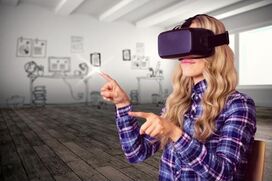
Should you use VR in your onboarding process?
Technology continues to change the way we work, from finding job postings to hiring and engaging in professional training as an established employee. Concepts that were once viewed as science fiction are now commonplace. Virtual reality is just one example.
Virtual reality and augmented reality systems have had a long road, from potentially promising idea to expensive but available and, now, relatively commonplace. With a smartphone, a headset and the right software or a specifically designed piece of equipment, people can have powerful experiences through immersion into an entirely virtual world.
The use of VR in onboarding is an important consideration that should be discussed by HR teams and other stakeholders in the process of getting new employees and current ones moving into significantly different roles up to speed.

Understanding the value and limits of VR
Virtual reality has a number of benefits in terms of onboarding when deployed in a carefully considered and thoughtfully constructed way. It can place new staff in situations common for seasoned employees in a more immersive and substantial way than roleplaying or training documents can by themselves. Simulating conversations with customers that require an abundance of tact or attention to detail is one such example. With VR, new employees can have experiences that simply weren't possible just a short time ago.
HR Technologist pointed to VR's ability to simulate real-life work situations and experiences as a major strength. Removing the abstraction of a script held by the trainer and the need for the trainee to act as if that person is a customer means more focus on the important matter at hand.
VR also lends itself to gamification - adding competitive, game-like elements to an activity or process - which can boost engagement. This can make the experience more memorable for new workers and create beneficial results for employers. While the overall goal is training and not to create a game, incorporating these factors can help the practical learning stick in the minds of new hires.
The Society for Human Resource Management pointed to an objective assessment of skills and competencies as one area where VR has demonstrated value. As long as the software providing the assessment is developed to provide a neutral, identical experience for all trainees, issues of personal bias in tracking results is minimized. With the same baseline to work from, it's easy to see where some new hires or departmental transfers might need more training. This allows for a more effective onboarding process that's personalized to the needs of each individual staff member.
"We are living in a data-driven world and the realm of HR is no different," says Bryan Verduzco, Division Director for Beacon Hill's Technologies Division in Sacramento. "When an organization's HR team puts their data to work through analytics they can gain perspective into traditional HR matters like training, hiring, and employee retention while shedding light into what processes and policies are contributing to overall employment satisfaction and success."
VR also has some limits that should be kept in mind if your organization is considering incorporating it into the onboarding process. Digital education-focused publisher eLearning Industry noted that there are plenty of areas where VR may only complicate the process. Incorporating quizzes into VR is one such example. Using head movement or a controller to select answers is more complicated than providing the same questions in a survey form on a computer or even with a pencil and paper. Limiting VR to areas where its strengths can be emphasized is a vital part of building an effective onboarding experience that incorporates it.
Finding great talent to onboard, through VR or otherwise
High-quality candidates are valuable to all businesses. Whether your organization wants to use VR onboarding or not, Beacon Hill is here to help your organization bring in the best talent possible.
 Back to Top
Back to Top


